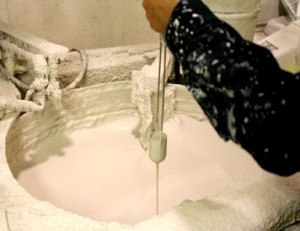The Importance of Viscosity Control
How much time is spent thinking about slurry viscosity control? My guess is, not much. It seems to be a necessary evil of running a shell room, but not an area where we spend a lot of time. What is the impact of the slurry viscosity being out of range? Operating...
New Year’s Resolutions Or Efficient New Year?
I don’t know about you, but, I tend to steer way from New Year’s Resolutions. I haven’t been all that great about keeping them and so, instead of motivating me, they tend to discourage me. But, from a business perspective, the new year brings opportunities to find...
Leave a Mark: Etch and Clean the Wax Molds
The mold cleaning and etch process seems to be one of those forgotten parts of the investment casting process. It isn’t like the parts look any cleaner when they come out of the tank. So, how important is this process to the overall process? The purpose of the...
Tis the Season: Managing Shell Drying during Summer
I love this time of the year when the warm weather finally appears! The plants are growing and life is good! However, it is also the time of the year when shell drying related issues start to creep up! So, I thought I’d share a few items to check if you start to see...
Answer a Question with a Question: Slurry Testing Frequency
I am frequently asked how often should I test my slurry? I know you shouldn’t answer a question with a question, but what about a series of questions? ✓ How often do you have to make adjustments to your slurry? ✓ Are the adjustments with water, binder or a mixture of...
Hitting the pH Target
Stability of colloidal silica is important for the health and performance of an investment casting slurry. pH is one indicator as to the stability. Conductivity is another important indicator and information on that topic can be found here. Accurate measurement of...
Clean Calibration: Maximizing Slurry Test Results
One of the most common slurry tests performed for investment casting slurries is SiO2 percentage. Insufficient concentration of SiO2 in the slurry creates a weak shell. However, having too high a concentration can also cause a weak shell while potentially gelling...
Data Collection and Slurry Control
I had a wise customer comment to me once that he didn’t mind collecting data as long as the operators/engineers were going use it for slurry control. I completely agree with that statement but would add: make sure the data you are gathering is meaningful. So, what...
A Balancing Act: Managing Slurry Conductivity
Last week, we discussed conductivity and how high levels can contribute to reduced slurry health. Now, we will discuss potential causes and what can be done about it. Some common causes of high conductivity are: ♣ Increase in the number and strength of ions ♣...









